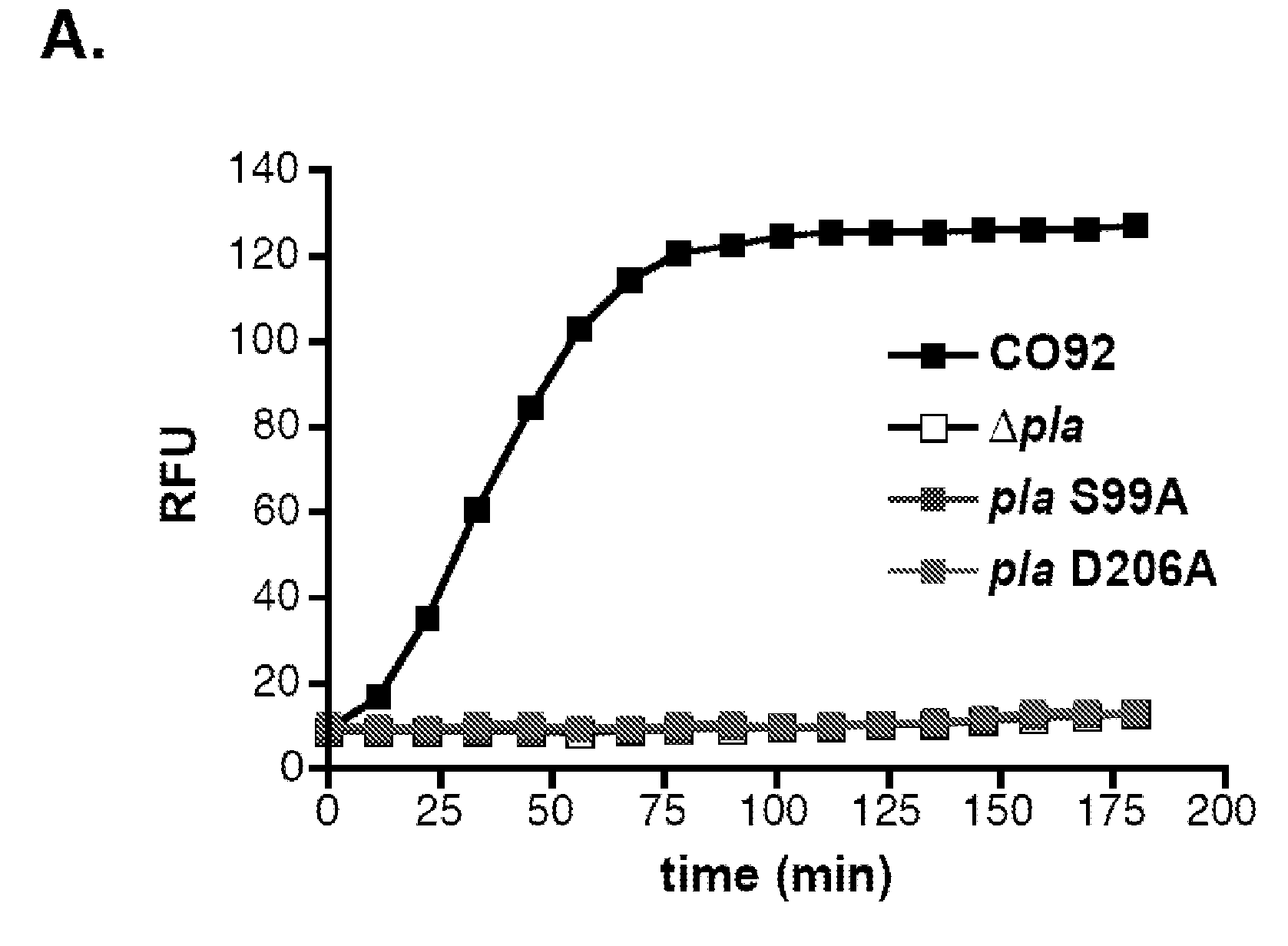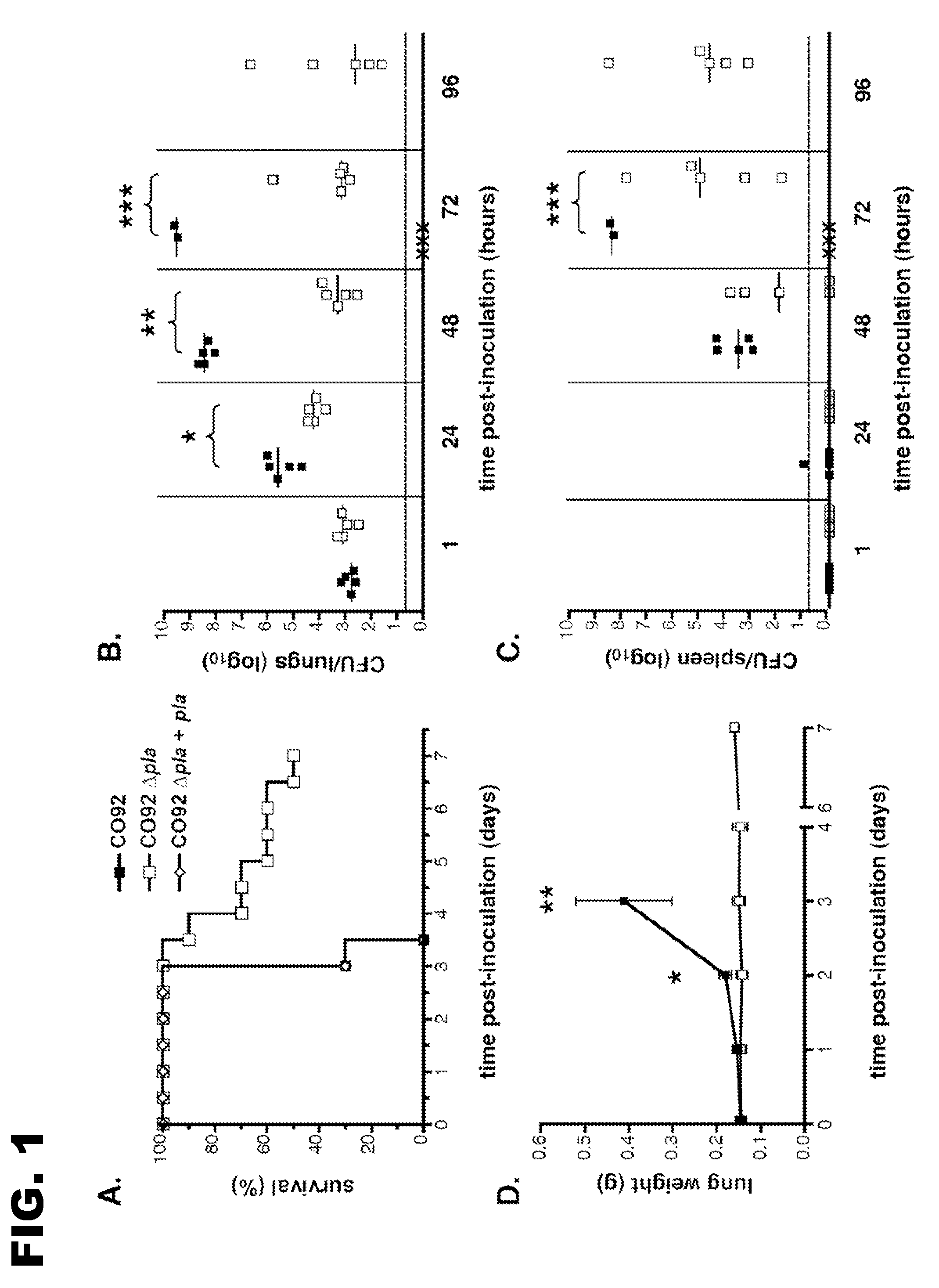Methods of treating pneumonic plague
a pneumonic plague and pneumonic plague technology, applied in the field of pneumonic plague treatment methods, can solve the problems of high contagiousness, epidemic of primary pneumonic plague, and almost always universally fatal, and achieve the effect of inhibiting the protease activity of pla and reducing the proliferation of y
- Summary
- Abstract
- Description
- Claims
- Application Information
AI Technical Summary
Benefits of technology
Problems solved by technology
Method used
Image
Examples
example 1
[0059]C57BL / 6 mice were infected intranasally with wild-type Y. pestis CO92, an isogenic Y. pestis strain lacking Pla (CO92 Δpla), or the Δpla strain complemented with coding sequence of Pla. Mice given wild-type Y. pestis CO92, a strain isolated from a fatal case of pneumonic plague (12), succumbed to the infection in a highly synchronous manner. In contrast, by 7 days post-inoculation, only 50% of the mice infected with the Δpla strain developed terminal plague, and the rate at which the mice died was significantly less synchronous than those infected with the wild-type strain (FIG. 1A). Complementation of the mutant with the coding sequence for Pla fully restored virulence to wild-type levels. Thus, the lack of Pla delayed the time to death and affected the synchronous nature of the disease in these mice. This delay led to the assessment of the bacterial load in the lungs and spleen (CFU / organ) at various times post-inoculation. As previously observed (13), the kinetics of bacter...
example 2
[0062]A hallmark of fatal bacterial pneumonia is the accumulation of edematous fluid in the lungs due to the disruption of cell-cell junctions in the bronchi and alveoli, allowing plasma leakage into the airspace. This accumulation can be measured by a change in gross lung weight, as the fluid and cells contribute to an increased mass of the organ. By 48 hours post-inoculation, mouse lungs infected with wild-type Y. pestis weighed significantly more than uninfected lungs, and by 72 hours were 3-4-fold heavier (FIG. 1D), indicating a severe pneumonia that is most likely the cause of death. Interestingly, the lungs of mice infected with the Δpla strain of Y. pestis showed no change in gross weight, even by 7 days, suggesting that the death of mice infected with this strain is not due to a fatal pneumonia but rather more likely caused by a systemic infection. Indeed, the appearance and proliferation of bacteria in the spleens is consistent with this observation. The results, therefore,...
example 3
[0064]Previous studies on the progression of pneumonic plague revealed an early anti-inflammatory stage that is maintained until the relatively sudden onset of a pro-inflammatory phase, beginning at approximately 36 hours post-inoculation (13). The lack of bacterial outgrowth and the presence of a restricted inflammatory infiltrate in response to Pla− Y. pestis in the lungs of mice suggest that the host immune state is able to control the pulmonary infection while preventing what otherwise becomes an overwhelming inflammatory reaction to the bacteria. With this in mind, the level of immune activation in the lungs was assessed using quantitative reverse-transcription PCR (qRT-PCR) to determine changes in transcript levels of multiple pro- and anti-inflammatory mediators. Consistent with earlier observations (13), mice infected with Y. pestis CO92 remained unresponsive to infection in the first 24-36 hours, with the majority of cytokines relatively unchanged compared to uninfected mic...
PUM
| Property | Measurement | Unit |
|---|---|---|
| emission wavelength | aaaaa | aaaaa |
| excitation wavelength | aaaaa | aaaaa |
| time | aaaaa | aaaaa |
Abstract
Description
Claims
Application Information
 Login to View More
Login to View More - R&D
- Intellectual Property
- Life Sciences
- Materials
- Tech Scout
- Unparalleled Data Quality
- Higher Quality Content
- 60% Fewer Hallucinations
Browse by: Latest US Patents, China's latest patents, Technical Efficacy Thesaurus, Application Domain, Technology Topic, Popular Technical Reports.
© 2025 PatSnap. All rights reserved.Legal|Privacy policy|Modern Slavery Act Transparency Statement|Sitemap|About US| Contact US: help@patsnap.com



